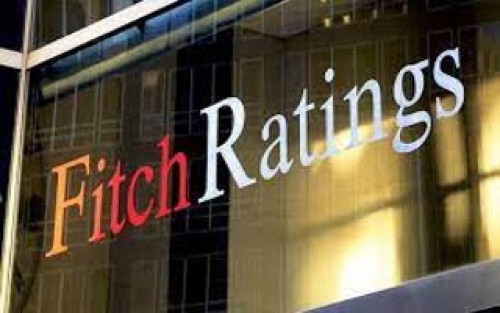NEW YORK, New York – The US-based Fitch Ratings has upgraded Jamaica’s long-term foreign-currency and local-currency Issuer Default Ratings (IDRs) to ‘BB-‘ from ‘B+’, noting also that the outlook remains positive.
 In addition, Fitch has upgraded Jamaica’s country ceiling to ‘BB’ from ‘BB-‘.
In addition, Fitch has upgraded Jamaica’s country ceiling to ‘BB’ from ‘BB-‘.
Fitch said the upgrade of Jamaica’s ratings to ‘BB-‘ reflects significant progress with debt reduction, backed by a sound fiscal framework and a strong political commitment to deliver large primary surpluses.
It said robust fiscal management has contributed to a turnaround in creditworthiness following the 2013 distressed debt exchange that Fitch considered a default.
“Aside from a COVID-19-related spike in 2020, debt-to-GDP has fallen every year for more than a decade, to a forecasted 73.5 per cent in fiscal 2023/2024 from a high of 135.3 per cent of GDP in fiscal 2012/2013”
Fitch said that although this remains above the ‘BB’ median of 52.2 per cent of gross domestic product (GDP), it represents the third largest decline in debt burden among all rated sovereigns over this period, noting that only Ireland and Iceland experienced a larger decline. “Concurrently, ‘B’ and ‘BB’ median debt-to-GDP increased over this period by 23 ppts and 14 ppts, respectively.”
Fitch said that the positive outlook reflectsits expectation of continued improvement in debt metrics and further deepening of the policy framework over the next few years.
It said Jamaica’s ‘BB-‘ rating is also supported by governance indicators that are substantially stronger than the ‘BB’ median.
“The ratings remain constrained by deep structural weaknesses, including subdued growth potential owing to a high crime rate, low productivity and weak demographics, as well as vulnerability to external (including weather-related) shocks.”
The rating agency said that the budget balance has improved significantly since 2020, when the pandemic support measures led to the first deficit since 2015.
“We forecast that the overall surplus will be J$9.1 billion (One Jamaica dollar=US$0.008 cents) or 0.3 per cent of GDP, with a primary surplus of J$181.9 billion or 6.1 per cent of GDP in fiscal 2023/2024.
“Revenues are forecast to grow by 14.5 percent year on year, exceeding the forecasted growth rate of nominal GDP and just a touch above expenditure growth. The higher-than-normal expenditure growth is being driven by a large increase in the public sector wage bill, which we expect to increase by nearly 50 per cent over the next three years.”
Fitch said that some of this increase is due to the reclassification of certain allowances from program expenditures to wages.
Fitch said it does not expect that the higher wage bill will push the fiscal balance into deficit, in part owing to fiscal space generated by the lower interest bill.
Fitch forecasts that large primary surpluses will reduce general government debt-to-GDP to 69.7 per cent by fiscal 2024/2025 and to around 66.4 percent in fiscal 2025/2026, putting it on target to meet the government’s 60 per cent debt target by 2028, which is still higher than the current ‘BB’ median of 52 per cent.
It said Jamaica has remained committed to an economic policy framework built on two key pillars, namely the Bank of Jamaica’s (BoJ) inflation-targeting monetary policy and fiscal policy anchored on debt reduction targets.
It said that the policy framework proved flexible enough to cope with the recent shocks without undermining medium-term fiscal and inflation expectations.
“The government has built a record of fiscal prudence that has gained credibility in recent years and may be further strengthened over the next several years, including through the successful implementation of the new fiscal commission.”
Fitch said that the BoJ’s independence and credibility have improved in recent years.
However, the bank does have to contend with some weakness in policy transmission, particularly given the country’s exposure to imported inflation.
Inflation has remained above the target band (four to six per cent) given recent hikes in transportation fares. Nonetheless, the bank is likely to cut its main policy rate, which is currently at seven per cent, later this year when inflation comes back down.
Regarding the island’s growth stabilizing potential, Fitch said the Jamaican economy stabilized following a rebound from the sharp pandemic-induced decline in 2020. Following two years of relatively rapid growth – 4.6 per cent and 5.2 per cent in 2021 and 2022 -Jamaica’s real GDP growth rate moderated to an estimated two per cent last year.
It said the recovery was boosted by the tourism rebound, especially owing to stopover visitors from the United States, the largest market.
“Fitch forecasts real growth to slow further to 1.8 per cent in 2024 and 1.7 per cent in 2025, in-line with its medium-term potential rate, estimated at between one and two per cent, which is particularly weak relative to rating peers.”
Jamaica has had a current account deficit (CAD) in the range of one to three per cent of GDP since 2015, a significant improvement over the prior decade when the CAD averaged 11.4 per cent.
“The CAD is amply funded by foreign direct investment inflows. While the current account balance contains a large trade deficit, it is offset by a tourism-driven services surplus and a large surplus on secondary incomes, consisting mainly of remittances from the diaspora,” Fitch added.


